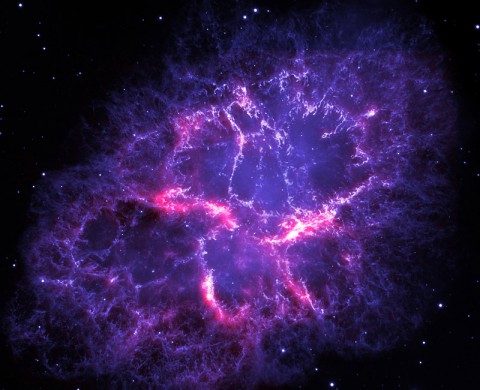Written by Whitney Clavin
NASA’s Jet Propulsion Laboratory
 Pasadena, CA – Astronomers have discovered a rare chemical pairing in the remains of an exploded star, called the Crab nebula. A gas thought to be a loner has made a “friend,” linking up with a chemical partner to form a molecule.
Pasadena, CA – Astronomers have discovered a rare chemical pairing in the remains of an exploded star, called the Crab nebula. A gas thought to be a loner has made a “friend,” linking up with a chemical partner to form a molecule.
The discovery, made with the Herschel space observatory, a European Space Agency mission with important NASA contributions, will help scientists better understand supernovas, the violent deaths of massive stars.

A new study, led by Michael Barlow from University College London, United Kingdom, and based on spectral data from Herschel, has found the first evidence of such a noble gas-based compound in space, a molecule called argon hydride. The results are published in the journal Science.
“The strange thing is that it is the harsh conditions in a supernova remnant that seem to be responsible for some of the argon finding a partner with hydrogen,” said Paul Goldsmith of NASA’s Jet Propulsion Laboratory, Pasadena, CA.
“This is not only the first detection of a noble-gas based molecule in space, but also a new perspective on the Crab nebula. Herschel has directly measured the argon isotope we expect to be produced via explosive nucleosynthesis in a core-collapse supernova, refining our understanding of the origin of this supernova remnant,” concludes Göran Pilbratt, Herschel project scientist at the European Space Agency.
Read the full ESA news release.
Herschel is a European Space Agency mission, with science instruments provided by consortia of European institutes and with important participation by NASA. NASA’s Herschel Project Office is based at JPL. JPL contributed mission-enabling technology for two of Herschel’s three science instruments.
The NASA Herschel Science Center, part of the Infrared Processing and Analysis Center at the California Institute of Technology in Pasadena, supports the United States astronomical community. Caltech manages JPL for NASA.
More information is online at http://www.herschel.caltech.edu , http://www.nasa.gov/herschel and http://www.esa.int/SPECIALS/Herschel .


